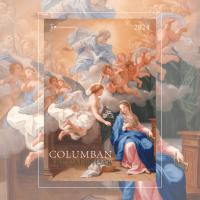
In 1922 the recently established Australian outpost of the Irish Mission to China, decided to produce a small calendar for the upcoming year as a fundraising venture. The 1923 Columban Art Calendar was not made for longevity. It was printed on thin paper, with each page being torn off at the perforated edge along its binding.
This inaugural calendar became the forerunner of the iconic Columban Art Calendar still produced today. The original calendar has photographs from China of landscapes, schools and missionaries. The 1923 calendar holds the masthead 'The Irish Mission to China' and each page has a message for Australian congregations and benefactors.
The first calendar was obviously a success as the 1924 edition was produced on heavy paper stock with a spiral binding for the viewer to turn the pages.
The only complete copy of the 1923 calendar that survived was mouldy and in desperate need of conservation work to stabilise the paper and remove active spores. In October 2017 the Columban Mission Centre deposited the calendar at The Grimwade Centre for Cultural Materials Conservation (CCCM).
The CCCM is part of the University of Melbourne and is described on their website as being “… the leading art conservation and restoration centre in Victoria and the only centre of its kind in Australia, combining both commercial conservation services and training in cultural material conservation.”
 Lisel Bladin alongside Adele Barbara observing the 1923 preserved
Lisel Bladin alongside Adele Barbara observing the 1923 preserved
Columban Art Calendar at CCCM, Melbourne.
Adele Barbara was the conservator who undertook the conservation treatment of the calendar over a period of several months. Adele compiled the following summary of her work: “When the Irish Mission to China calendar first arrived at the Grimwade Centre, it was in need of conservation work to reduce the mould growth and thoroughly clean and stabilise the calendar so that it could be enjoyed for many years to come.
Initially, each page of the calendar was thoroughly vacuumed to remove the mould spores on the surface. This was followed by a UV treatment to help sterilise any remaining mould. To remove dirt and degradation products from within the paper substrate it was necessary to wash each page of the calendar. It was discovered, however, that the red ink that features on each page was highly sensitive. To overcome this obstacle the calendar pages were washed in stages on a suction table. This method allowed for the soluble red media to be carefully blocked off while the rest of the page could be gently sprayed with a fine mist of deionised water which draws the dirt out of the paper with the power of suction.
Areas of dark staining left from the mould growth were focused on during the washing process, with damp cotton swabs passed over these areas to draw out more discolouration. After washing, some of the very fragile pages were resized with a cellulose-based solution, which imparts greater strength and durability to the paper.
Following the washing stages, tears and losses were carefully repaired using thin pieces of Japanese tissue, which was adhered to each page with gluten-free wheat starch paste, a reversible adhesive. Some of the more fragile pages with lots of tears were fully lined with Japanese tissue, to ensure that the pages were made stronger and could be handled safely after the treatment. Following the repair process, areas of loss were filled with infills made of Western paper. This paper was toned with acrylic paints and pencils to compliment the colour of the calendar.
Finally, the pages were humidified to relax and flatten them. After a week of pressing, each page of the calendar was reunited and placed in a custom-made archival folder to ensure it can be stored safely.
This comprehensive process of cleaning, washing, repairing and infilling will help to ensure that St Columbans Mission Society can preserve their history and enjoy this calendar into the future.”
Lisl Bladin is the Archivist at the Columban Mission Centre in Essendon.
![]() LISTEN TO: History preserved
LISTEN TO: History preserved
(Duration: 5:17mins, MP3: 2.42MB)
Related links
- Read more from The Far East, July 2018

